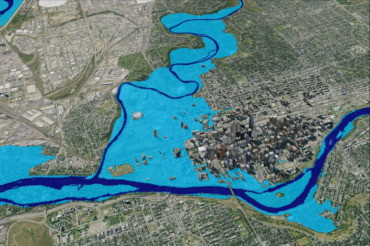
Don’t count on Canada-wide, high-resolution flood modelling anytime soon
October 10, 2019 by Greg Meckbach
Print this page Share
Flood maps with a resolution of two metres would be ideal, but don’t expect anything like this Canada-wide anytime soon.
The current standard for the spacing of a topographic grid for regional mapping and modelling is 30 metres, as the the Canadian Water Network noted in a recent study, Improving Flood Risk Evaluation through Cross-Sector Sharing of Richer Data. The study found this standard is too coarse to represent fully the results of pluvial flooding, which results from intense rainfall events.
In Canada, digital terrain models for flood mapping have a resolution of 30 by 30 meters. The Insurance Bureau of Canada would like to improve that to five by five meters or better, IBC federal affairs vice president Craig Stewart told Canadian Underwriter earlier.
 IBC was a partner for the Canadian Water Network in the pilot test, which was done in Edmonton, Regina, Halifax, Windsor and the Town of Tecumseh, Ont., which borders Windsor to the east. Founded as a result of the Walkerton, Ont. water contamination tragedy, the Canadian Water Network has a board comprised of members from academia, municipalities, utilities and conservation authorities.
IBC was a partner for the Canadian Water Network in the pilot test, which was done in Edmonton, Regina, Halifax, Windsor and the Town of Tecumseh, Ont., which borders Windsor to the east. Founded as a result of the Walkerton, Ont. water contamination tragedy, the Canadian Water Network has a board comprised of members from academia, municipalities, utilities and conservation authorities.
There may be an advantage to having flood maps with a two-metre resolution in certain areas such as dense urban centres, the Water Network suggests in its Oct. 11 report.
During the pluvial flood modelling pilot, participating municipalities tested flood modelling with two-metre resolution. This provided much greater detail (compared to 30-metre resolution) and improved the predictability of the results. But it also had a significant impact on the time it took for the computers to run the models, the network said in the report.
“A dense dataset is likely too costly and impractical to produce national-scale pluvial flood maps. A 5-metre grid spacing reduces processing time, with minimal reduction in output quality as compared to finer grid spacing. However, it may be advantageous to use 2-metre grid spacing in certain key areas, such as dense urban centres.”
Having higher resolution makes it easier to model the impact of things like storm sewers, dikes and dry ponds.
The full report, published this past June, was not made public because it has proprietary information from the modelling firms, as well as private data from the participating municipalities, a spokesperson for the Canadian Water Network told Canadian Underwriter.
The topographical data was provided by Natural Resources Canada.
Have your say: